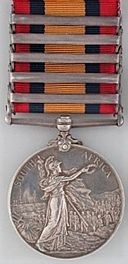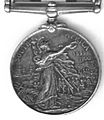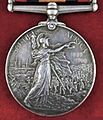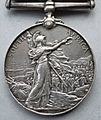Queen's South Africa Medal facts for kids
Quick facts for kids Queen's South Africa Medal |
|
|---|---|
 
Obverse and reverse of the medal
|
|
| Country | |
| Type | Military Campaign medal |
| Eligibility | British and Colonial forces |
| Awarded for | Campaign service |
| Campaign(s) | Second Boer War |
| Clasps | 26 |
| Statistics | |
| Established | 1900 |
| Order of wear | |
| Next (higher) | East and Central Africa Medal |
| Next (lower) | Queen's Mediterranean Medal |
| Related | King's South Africa Medal Kimberley Star Cape Copper Company Medal for the Defence of O'okiep |
Ribbon bar |
|
The Queen's South Africa Medal was a special award given to soldiers and even some civilians. It honored those who served in the Second Boer War in South Africa. This war happened between 1899 and 1902. The medal came with different "clasps," which were metal bars added to the ribbon. These clasps showed that the person took part in specific battles or parts of the war. There were 26 different clasps in total.
Contents
About the Medal
When the Medal Started
Queen Victoria created the Queen's South Africa Medal in 1900. It was for anyone, military or civilian, who served in South Africa during the Second Boer War. This war lasted from October 11, 1899, to May 31, 1902.
At first, people thought the war would end quickly in 1900. So, the first medals made had the years "1899" and "1900" on the back. But the war lasted much longer! Because of this, the years were removed from the medal designs. Most medals were made without any dates on them.
The Second Boer War: A Tough Fight
The Second Boer War was very difficult. Soldiers often faced challenges like not enough food or water. Many also got sick with diseases like enteric fever, which caused many casualties. The enemy, the Boers, were skilled horsemen and excellent shots. They used "guerrilla warfare," which means they fought in small, surprise attacks. This made the war very hard to win. Over 97,000 people were affected by the war, including those who died from disease.
Who Received the Medal?
The Queen's South Africa Medal was given to all British-led forces. This included soldiers from the British Army, Royal Navy, and nurses. Forces from countries like Australia, Canada, New Zealand, and India also received it. Local groups from the Cape Colony and Colony of Natal in South Africa were also honored. Even civilians working for the military and war reporters could get the medal. About 178,000 medals were given out in total.
- Nurses and Royal Navy members who stayed offshore received the medal without any clasps.
- Troops guarding Boer prisoners on Saint Helena island also received it without clasps.
A different medal, the King's South Africa Medal, was created later in 1902. It was for those who served after January 1, 1902, and had been in the war for at least 18 months. If someone got the King's Medal, they also received the Queen's Medal.
What the Clasps Mean
Twenty-six different clasps were awarded with the Queen's South Africa Medal. These clasps showed which specific battles or campaigns a person took part in. Some people received as many as nine clasps! The clasps were divided into three main types:
- Battle Clasps: These were for specific battles or actions. For example, if you helped defend or relieve a city like Mafeking, Kimberley, or Ladysmith, you'd get a clasp for that.
- State Clasps: These were for serving in a particular region or "state" if there wasn't a specific battle clasp for that area.
- Date Clasps: These two clasps, "South Africa 1901" and "South Africa 1902," were usually given with the King's South Africa Medal. However, if someone wasn't eligible for the King's Medal, they would wear these date clasps with their Queen's South Africa Medal.
The clasps were always worn in a specific order, starting from the bottom of the ribbon and going upwards. This order was based on when the battles or campaigns happened. Sometimes, new clasps were sent out later, so they might not have been attached in the perfect order.
Here are some of the clasps and what they meant:
- CAPE COLONY: For service in the Cape of Good Hope region.
- NATAL: For service in the Natal region.
- RHODESIA: For service in Rhodesia.
- RELIEF OF MAFEKING: For helping to free the town of Mafeking from a siege.
- DEFENCE OF KIMBERLEY: For defending the town of Kimberley during its siege.
- TALANA: For fighting in the Battle of Talana Hill.
- ELANDSLAAGTE: For fighting in the Battle of Elandslaagte.
- DEFENCE OF LADYSMITH: For defending Ladysmith during its siege.
- BELMONT: For fighting in the Battle of Belmont.
- MODDER RIVER: For fighting in the Battle of Modder River.
- TUGELA HEIGHTS: For fighting in the Battle of Tugela Heights.
- RELIEF OF KIMBERLEY: For helping to free Kimberley.
- PAARDEBERG: For fighting in the Battle of Paardeberg.
- ORANGE FREE STATE: For service in the Orange Free State region.
- RELIEF OF LADYSMITH: For helping to free Ladysmith.
- DRIEFONTEIN: For fighting in the Battle of Driefontein.
- WEPENER: For defending Wepener.
- DEFENCE OF MAFEKING: For defending Mafeking during its siege.
- TRANSVAAL: For service in the South African Republic (Transvaal) region.
- JOHANNESBURG: For fighting near Johannesburg.
- LAING'S NEK: For operations at Laing's Nek Pass.
- DIAMOND HILL: For fighting in the Battle of Diamond Hill.
- WITTEBERGEN: For operations in the Wittebergen mountains.
- BELFAST: For fighting in the Battle of Bergendal (near Belfast).
- SOUTH AFRICA 1901: For service in South Africa during 1901.
- SOUTH AFRICA 1902: For service in South Africa during 1902.
Medal Design
The Queen's South Africa Medal is a round disk, about 38 millimeters wide. Most were made of silver, but some were bronze. The bronze medals were given to non-fighting Indian troops and other non-combatant workers.
Front of the Medal (Obverse)
The front of the medal shows a picture of Queen Victoria wearing her crown and veil. Around the edge, it says "VICTORIA REGINA ET IMPERATRIX," which means "Victoria, Queen and Empress" in Latin.
Back of the Medal (Reverse)
The back of the medal was designed by G. W. de Saulles. It shows Britannia, a symbol of Britain, holding the Union Flag (the British flag) and a laurel wreath (a symbol of victory). In the background, you can see soldiers marching and two warships. At the top, it says "SOUTH AFRICA."
There were three slightly different versions of the back of the medal:
- The first version had the years "1899" and "1900" written below Britannia's wreath. Only about fifty of these were given out.
- For the second version, the years were removed, but sometimes you could still faintly see where they used to be.
- The third version was made with new designs that never had the years on them.
Clasps and Naming
The clasps were attached to the medal's ribbon. Sometimes, clasps were sent out later than the medal itself. This meant they might not have been attached perfectly or were worn loosely. The name and other details of the person who received the medal were usually stamped on its edge.
The Ribbon
The medal's ribbon is 32 millimeters wide. It has a red stripe, a dark blue stripe, a wide orange stripe in the middle, and then the dark blue and red stripes repeated.
How Medals Are Worn
Medals are worn in a specific order, usually based on when the campaign or event they honor happened. The Queen's South Africa Medal is worn after the East and Central Africa Medal and before the Queen's Mediterranean Medal.
In South Africa, after 1952, new South African medals were created. These new medals were generally worn before older British medals, except for the very special Victoria Cross.
See also




